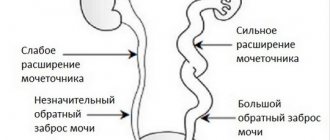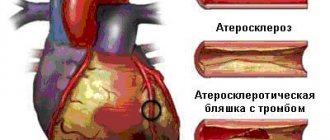Causes of nephrotic syndrome
The immunological concept of the development of nephrotic syndrome is widespread, which is due to the occurrence of the syndrome as a result of autoimmune diseases and allergic reactions. The connection of antibodies with internal or external antigens promotes the formation of circulating immune complexes in the blood, the sedimentation of which leads to an inflammatory process and impaired circulation in the capillaries.
There are two types of antigens - exogenous (viruses, bacteria) and endogenous (genetic heredity). The severity of kidney destruction depends on the structure and duration of the effect on the body. Activated processes against the background of immune reactions provoke the formation of inflammatory processes and a negative effect on the basement membrane of the capillary glomeruli, which leads to their increased penetration.
At the initial stage of nephrotic syndrome, mechanisms operate that cause injury to the membranes and cells of the glomeruli, inflammatory processes and immunoallergic reactions. Causes of nephrotic syndrome:
- complex diseases (affecting the whole body):
- rheumatoid arthritis - inflammation of connective tissue (joints);
- lupus erythematosus is a pathology that affects the internal organs and skin of a person;
- Granulomatosis is a disease that promotes the formation of nodules.
- infectious diseases:
- a source of putrefaction that goes undiagnosed for a long time;
- tuberculosis;
- endocarditis - inflammation of the lining of the heart from the inside, which progresses as a result of infection;
- Human immunodeficiency virus (HIV) is a viral infection of elements of the immune system.
- liver diseases (hepatitis B and C);
- blood cancer - dysfunction of the bone marrow, which leads to an increase in the number of cells in the blood;
- diabetes mellitus - improper metabolism of sugar, which causes an increase in its concentration in the blood;
- heart failure - damage to the blood flow in the kidneys caused by the inability of the heart to pump blood in the right amount;
- taking antibiotics, anticonvulsants and anti-inflammatory medications;
- allergies, heavy metal poisoning;
- tumors (lymphoma, melanoma);
- chronic pathologies;
- mixed diseases.
general information
What is nephrotic syndrome?
This is a condition in which the glomerular system of the kidneys is affected due to infectious and autoimmune processes occurring not only at the level of the urinary system, but also at the general level of the body. The cause is system-wide diseases, for example, with diabetes mellitus the symptoms are very pronounced.
About a third of diseases of the urinary system include such manifestations. Age categories at risk of developing the disease include young children, adults, and the elderly. Complications of nephrotic syndrome in old age as a result of systemic diseases more often affect women.
Signs
When a clinical picture of kidney damage occurs, specific signs of nephrotic syndrome are identified regarding biochemical parameters:
- Volume of proteins in urine. Volumes exceeding 3.5 g/day are called hyperproteinuria.
- Reduced levels of protein in the blood.
- High blood cholesterol levels. The limit value is considered to be 6.5 mmol/l.
- Swelling. The severity of this symptom increases over time and develops into general swelling of the entire body.
If the clinical picture is not represented by all signs, then the pathological condition is defined as incomplete or reduced.
Symptoms of nephrotic syndrome
The signs of nephrotic syndrome are determined by the form, characteristics and nature of the disease, which caused the appearance of this pathology.
The following symptoms of nephrotic syndrome are observed:
- Edema, the specificity of which is the concentration of a large amount of fluid in the tissues. Initially, it forms on the face (cheeks, around the eyes), and after a while it spreads to other parts of the body. Excessive swelling can cause anasarca (swelling of the entire body) and ascites (fluid in the abdominal cavity).
- Changes in the skin and hair structure, resulting in brittleness and dryness.
- Anemia is a disorder of erythropoietin metabolism, which promotes the production of red blood cells in the bone marrow. Characteristic signs of anemia may include shortness of breath, dizziness, pallor and weakness.
- Disorder of the general condition of the body. Together, swelling and anemia lead to impaired activity, which can cause severe headaches.
- Dyspeptic symptoms (disruption of the normal functioning of the stomach) - the release of nitrogen metabolism products through the mucous membrane of the gastrointestinal tract, the special signs of which may be bloating, lack of appetite and nausea.
- A change in the volume of urine caused by impaired blood flow in the kidneys, which leads to a decrease in the amount of urine excreted, can trigger the development of kidney failure. Due to the abundance of protein and fats, urine becomes cloudy in color.
Reasons for development
The term "nephrotic syndrome" was introduced into medical science in the mid-twentieth century. Until this time, the terms “nephrosis” and “lipoid nephrosis” were used. The latter is used in modern medical practice only in relation to pathology diagnosed in a child. In adult patients, it is customary to talk about lipoid nephrosis only when minimal deviations in the structure of the renal glomeruli are recorded.
The reasons for the development of pathology vary depending on its belonging to one of the two types of classification.
Changes are primary when they develop against the background of kidney diseases. Most often we are talking about glomerulonephritis, pyelonephritis. If a newborn is diagnosed with certain native abnormalities in the structure of the kidneys, in most cases this leads to changes in their functioning, characterizing congenital nephrotic syndrome.
Secondary pathologies are spoken of when they were provoked by diseases that involved the urinary system in the process.
Thus, the reasons for the appearance of a primary symptom complex are:
- Glomerulonephritis: - membranous; - mesangial proliferative; - membranous-proliferative.
- Idiopathic nephrotic syndrome diagnosed in children.
- Focal segmental glomerulosclerosis.
The described pathology with a secondary development path can be caused by the following diseases and conditions:
- diabetes;
- nephropathic amyloidosis;
- tuberculosis;
- malaria;
- syphilis;
- Libman-Sachs disease;
- rheumatoid arthritis;
- scleroderma;
- nephropathy in pregnant women;
- hemorrhagic vasculitis;
- Hodgkin's lymphoma;
- malignant tumors from plasma cells;
- subacute bacterial endocarditis;
- inflammation of the arterial wall of blood vessels;
- allergies;
- kidney damage from medications (for example, penicillamine);
- intoxication with heavy metals (lead, mercury, gold);
- bites of poisonous snakes and insects.
Acute nephrotic syndrome, the pathogenesis of which is immunological in nature, is characterized by sudden onset symptoms. We are talking about the chronic course of the disease in cases where the pathology progresses gradually.
The described deviations can be either congenital or acquired.
Diagnosis of nephrotic syndrome
Diagnosis of nephrotic syndrome is based on symptoms and clinical and laboratory tests, which consist of a number of activities and procedures:
- anamnesis is the collection of information through a conversation with the patient during a medical consultation, where data is clarified about the presence of infectious and chronic diseases, the presence of kidney pathologies among relatives, when and what the first signs of the disease appeared, whether the patient had previously suffered from this disease;
- examination of the patient’s condition by inspection and palpation (condition of the skin, joint system, nature and presence of edema);
- a blood test, which consists of the following set of tests: a general blood test, which will help determine the content of leukocytes and platelets, the level of hemoglobin and red blood cells (typical of anemia);
- biochemical blood test: allows you to study the functioning of internal organs and metabolic processes in the body. During the study, it is possible to diagnose changes in kidney function, cholesterol and protein metabolism;
- An immunological blood test helps determine the number, volume and activity of immune cells, as well as the presence of antibodies in the blood. Before taking this test, the patient is not recommended to drink alcohol or exercise.
- general urinalysis: allows you to determine the synthetic composition and physical properties of urine;
- X-rays of light;
Existing treatments
Patients with the symptom complex under consideration can be hospitalized in a hospital if this is necessary to determine the underlying disease or in the case when complications develop (blockage of a vessel with a blood clot, sepsis of a bacterial nature, and so on).
Treatment of nephrotic syndrome is aimed at quickly relieving the main symptom – edema – and at the mechanism of development of the underlying disease.
In general, patients are prescribed and prescribed:
- Maintaining bed rest.
- A diet with a reduction in the amount of table salt.
- Mandatory control of drinking regime.
- Medications.
Drug therapy involves taking drugs from one or more groups, depending on the etiology of the condition:
- Symptomatic. In this case, these include rutin, ascorbic acid, diuretics, antihistamines, antibiotics, and calcium supplements.
- Immunosuppressive. Glucocorticoids (Prednisolone and its analogs), anticoagulants (Heparin, Omefin), cytostatics (Azathioprine, Cyclophosphamide).
- Anti-inflammatory drugs (Voltaren, Indomethacin).
- Drugs that prevent blood clots (“Dipyridamole”, “Curantil”).
In cases where drug therapy and compliance with medical recommendations have not brought results, procedures of plasmacytopheresis, hemosorption, and intravenous administration of ultra-high loading doses of corticosteroids may be prescribed.
A good effect is achieved by combining drug therapy with sanatorium-resort treatment in appropriate recreational areas. Recovery in such conditions occurs faster and the results of treatment last for a long period.
Treatment of nephrotic syndrome
Treatment for nephrotic syndrome depends on what caused the disease. In addition to the main drugs that are intended to eliminate the syndrome, treatment is prescribed that is focused on eliminating the cause of the disease.
During the treatment of nephrotic syndrome, the patient may be prescribed the following drugs:
- Glucocorticosteroids, they have antiallergic, anti-edematous and anti-inflammatory effects. Taking such medications, the patient may experience sleep disturbances, increased appetite, and an attack of psychosis.
- Cytostatics can be prescribed either independently or simultaneously with glucocorticosteroids. This drug is prescribed when hormonal therapy is not effective, as well as for people with contraindications to the use of glucocorticosteroids.
- Immunosuppressants are forced suppression of the immune system in diseases of an autoimmune nature, which is aimed at producing antibodies.
- Diuretics: aimed at reducing swelling by increasing urine production.
- Infusion therapy is the intravenous infusion of special drugs into the bloodstream, which normalizes metabolism and blood circulation.
- Antibiotics: help eliminate the development of viruses and infections.
- Compliance with a diet, the severity of which depends on the characteristics of edema, the ability of the kidneys to remove nitrogen-containing residues and the level of protein in the blood.
Treatment of NS
Therapy of nephrotic syndrome requires an integrated approach, consisting of symptomatic treatment of the condition, elimination of the causes of the development of pathology and correction of the patient’s lifestyle. Surgical treatment of NS is not practiced, but the disease may be accompanied by conditions requiring complete or partial resection of the kidney. To develop treatment tactics, consultation with a nephrologist is required, as well as a number of other specialists, depending on the causes of the disease.
The treatment strategy is formed by a nephrologist after conducting a comprehensive examination and identifying the true causes of nephrotic syndrome
Pharmacological therapy
As part of the general medicinal effect on the body, the following groups of drugs can be used:
- Glucocorticosteroids are a group of steroid hormones that are produced by the adrenal glands in the human body. These drugs have anti-inflammatory, anti-edematous, anti-shock, anti-allergic and immunosuppressive properties. The most commonly prescribed medications are Prednisone, Prednisolone, Triamcinolone;
- cytostatics are drugs whose action is aimed at inhibiting or slowing down cytological (cellular) division. Cytostatics are taken as a substitute for glucocorticosteroids or together with them to enhance the effect, for example, in case of resistance (lack of result) to hormonal treatment. These may be the following drug options: Cyclophosphamide, Chlorambucil;
- Immunosuppressants are drugs that suppress the body’s immune responses, which are widely used in autoimmune forms of nephrotic syndrome. The medications prescribed are Azathioprine or Cyclosporine;
- Diuretics are drugs that increase urine output, which occurs by blocking the reabsorption of sodium and water in the kidneys. Medicines are used for symptomatic treatment and are used to combat edema. Furosemide, Spironolactone, Indapamide can be used for therapeutic purposes;
- Antibiotics are drugs that suppress bacterial infections that may cause nephrotic syndrome. The following medications can be used: Cefazolin, Doxycycline, Ampicillin.
Diet
Diet correction is the most important stage in the treatment of nephrotic syndrome. The diet is based on the following principles:
- optimal daily caloric intake is 2750–3150 kilocalories;
- 5–6 meals during the day;
- method of cooking - boiling, stewing, raw consumption;
- reducing salt consumption to 2 grams per day until completely abstaining from it;
- consumption of protein-rich foods;
- reduced fluid intake;
- consumption of foods rich in potassium;
- preference for foods rich in carbohydrates;
- daily consumption of animal fat is up to 80 grams.
For nephrotic syndrome, foods should be as light as possible, including dietary soups, vegetable salads, cereals and vegetable oils
The following products should be avoided throughout the treatment cycle:
- fatty meats;
- fatty dairy and fermented milk products (sour cream, butter, cottage cheese);
- bread and bakery products;
- sour, salty and spicy dishes;
- legumes;
- chocolate;
- strong tea and coffee.
Products recommended for consumption:
- chicken, rabbit, quail;
- bream, cod, pike perch;
- vegetable and butter;
- bread from durum cereals without salt;
- low-fat dairy products;
- cereals and pasta;
- vegetables;
- fruit and herbal infusions.
Traditional medicine methods
Folk remedies can be included in the overall treatment strategy as auxiliary tools. The following recipes have a general anti-inflammatory, diuretic and tonic effect:
- Grind 100 grams of dry birch leaves and pour two glasses of hot water. Cover the container with the mixture with a lid and leave to infuse in a warm, dark place for 6 hours. At the end of the time, the composition should be filtered and taken three times a day, half a glass after meals;
- Pour a tablespoon of dry grated apple peel into a glass of boiling water and leave for an hour. The resulting composition is taken twice a day, half a glass;
- Mix St. John's wort, strawberry and currant leaves in equal proportions, pour one tablespoon of the dry mixture into a glass of boiling water and leave for 15 minutes. The infusion is used instead of tea in the morning on an empty stomach.
Prognosis and prevention for nephrotic syndrome
In case of late diagnosis and incorrectly selected treatment, nephrotic syndrome can provoke various kinds of complications. This may include: growth retardation, lack of protein in the body, brittle nails and hair, muscle pain and weakness, and baldness.
The main threat of nephrotic syndrome will be the body's increased sensitivity to inflammatory processes, which is caused by viruses, bacteria and microorganisms. This is due to decreased body defense as a result of loss of immunoglobulins.
Nephrotic syndrome can cause the following diseases:
- hypertension, in case of fluid retention in the body and kidney dysfunction;
- anorexia is a loss of appetite that is caused by swelling of the abdominal cavity (ascites);
- chronic edema;
- hypocalcemia, which occurs as a result of taking large amounts of steroid drugs;
- venous thrombosis;
- atherosclerosis;
- hypovolemia is a decrease in plasma fluid in tissues. It is accompanied by abdominal pain and cold extremities.
In case of late diagnosis and incorrectly selected treatment, nephrotic syndrome can provoke various kinds of complications. This may include: growth retardation, lack of protein in the body, brittle nails and hair, muscle pain and weakness, and baldness.
The main threat of nephrotic syndrome will be the body's increased sensitivity to inflammatory processes, which is caused by viruses, bacteria and microorganisms. This is due to decreased body defense as a result of loss of immunoglobulins.
Nephrotic syndrome can cause the following diseases:
- hypertension, in case of fluid retention in the body and kidney dysfunction;
- anorexia is a loss of appetite that is caused by swelling of the abdominal cavity (ascites);
- chronic edema;
- hypocalcemia, which occurs as a result of taking large amounts of steroid drugs;
- venous thrombosis;
- atherosclerosis;
- hypovolemia is a decrease in plasma fluid in tissues. It is accompanied by abdominal pain and cold extremities.
Prevention
The main preventive measure for nephrotic syndrome will be timely diagnosis of the disease and qualified treatment of renal complications and systemic diseases of the body that contribute to the formation of this pathology. During treatment, it is very important to follow the doctor’s prescription and recommendations, which include following a diet, avoiding alcohol and limiting physical activity.
A pregnant woman with a family history of nephrotic syndrome is recommended to undergo antenatal diagnostics to determine the congenital pathology of the fetus.
Treatment prognosis
When the disease can be treated with steroids, the prognosis is good. Symptoms disappear relatively early. Most often, in 90% of cases, the disease does not return and a complete recovery occurs.
However, the future may not be so bright due to possible complications. These include infections, azotemia, venous thrombosis, hematuria and hypertension. A kidney transplant also increases the risk of complications and relapses.
Those syndromes that cannot be eliminated with glucocorticoids are more severe. The selection of therapy takes longer, treatment will be more difficult.
Symptoms
During nephritic syndrome there are three stages: acute, subacute, chronic. The clinical picture of the pathology consists of signs of urinary, edematous and hypertensive syndromes.
The acute stage develops in patients 7–14 days after infection or exposure to another causative factor.
Symptoms of the pathology are:
Hematuria - blood in the urine, patients' stools resemble meat slops;- Swelling of soft tissues - the eyelids swell in the morning, the entire face and neck swell by lunchtime, and in the evening the ankles and legs;
- Moon-shaped and puffy face;
- Permanent arterial hypertension with the development of bradycardia and other signs of heart failure;
- Oliguria;
- Decreased immune defense;
- Pain syndrome - headache, pain in the abdominal and lumbar region;
- Constant thirst;
- Weight gain;
- Dyspeptic symptoms – nausea, vomiting, flatulence, bowel dysfunction;
- Fever, chills, sweating;
- General weakness, malaise, drowsiness.
If you ignore the above manifestations and do not treat the syndrome, its acute form will quickly become chronic.
The chronic stage of nephritic syndrome is a sluggish process in which symptoms are moderate or mild. The pathology manifests itself clinically a couple of weeks after the onset of inflammatory changes in the glomeruli of the kidneys. This form of the disease is difficult to cure. Specialists eliminate not only the causes and symptoms of the syndrome, but also all existing complications. The subacute stage is extremely rare. In this case, the symptoms of the disease develop rapidly, and renal failure forms within a few months.
Diagnosis of nephritic syndrome in children is based on the symptoms of the disease and laboratory data. In children, the main cause of pathology is streptococcal infection, which occurs in the form of pyoderma, tonsillitis or pharyngitis. Stressful and conflict situations, physical overstrain or hypothermia can provoke glomerular disorders.
acute glomerulonephritis
The course of the pathological process and the effectiveness of treatment depend on a number of factors: age, cause of the disease, the presence of other somatic ailments, long-term antibacterial therapy. Children are much more susceptible to the disease than adults. This is due to the good susceptibility of the child’s body to corticosteroid therapy. In children, the syndrome develops much more often than in adults, which is due to high vascular permeability and not fully formed immunity. The color of the child’s urine changes, fresh blood or whole clots appear in it. Sick children drink a lot, but practically do not go to the toilet. The volume of urine excreted decreases each time. It becomes cloudy and smells unpleasant. Children eat poorly, lose weight before our eyes, and complain of abdominal pain.
Complications of the syndrome:
- Progression of left ventricular failure,
- Acute renal failure,
- Pulmonary edema,
- Anuria,
- Hypervolemia and electrolyte disturbances,
- Renal eclampsia,
- Uremic intoxication,
- Cramps,
- Loss of consciousness,
- Uremic coma.
Therapeutic measures
Treatment of nephritic syndrome consists of eliminating the underlying disease that became its root cause. Patients are hospitalized in the nephrology department. Experts recommend that patients limit fluid intake, monitor diuresis, and maintain bed rest.
Patients are prescribed diet therapy, which consists of completely eliminating salt from the diet and limiting protein foods. Allowed: vegetarian soups, dairy and fermented milk products, low-fat fish and meat, cereal products, fruit drinks, rosehip decoction, natural juices. Spicy, pickled, spicy, smoked foods, strong coffee, tea, and alcohol are prohibited. Nutrition should be balanced and enriched with vitamins.
Drug therapy:
In case of infectious etiology of the syndrome, antimicrobial agents are prescribed - Cephalexin, Amoxicillin, Azithromycin.- Immunosuppressive therapy is carried out using cytostatics and glucocorticoids - Prednisolone, Methylprednisolone.
- Diuretics reduce the volume of circulating blood - “Diacarb”, “Veroshpiron”.
- Antiplatelet agents and anticoagulants – “Curantil”, “Heparin”.
- To treat arterial hypertension, calcium channel blockers and ACE inhibitors are used - Enalapril, Bisoprolol.
- Pre- and probiotics allow you to restore the intestinal microflora - “Bifiform”, “Lactofiltrum”, “Enterol”.
- Immunostimulants increase the body's resistance to infection - “Imunorix”, “Ismigen”.
- Multivitamins – “Vitrum”, “Centrum”.
- Herbal medicines that support kidney function - “Cyston”, “Canephron”.
- NSAIDs according to indications - “Ibuprofen”, “Nurofen”, “Diclofenac”.
- Antihistamines - “Suprastin”, “Cetrin”, “Diazolin”.
- Restoring hemodynamics and improving microcirculation - Actovegin, Cavinton.
- Dialysis therapy and plasma exchange are indicated for the rapid development of renal failure.
Herbal medicine used to relieve the symptoms of pathology: infusion of dried rose hips, birch leaves, dandelion, horsetail, celery juice, birch sap, decoction of corn silk, sea buckthorn.
If long-term symptomatic therapy and a strict regimen do not restore kidney function and eliminate the cause of the disease, they move on to more radical measures - kidney transplantation.
Prevention and prognosis
Measures to avoid the development of nephritic syndrome:
- Competent antibiotic therapy for streptococcal infections, taking into account the sensitivity of the isolated microbe to drugs,
- Sanitation of chronic foci of infection,
- Blood sugar control
- Avoiding overeating
- Optimization of work and rest,
- Timely completion of medical examinations,
- Periodic ultrasound of the kidneys,
- Strengthening immunity,
- Maintaining a healthy lifestyle,
- Sports activities,
- Hardening,
- Balanced diet,
- Fighting bad habits
- Dispensary observation of those who have been ill for a year.
In the absence of adequate treatment for the syndrome, the presence of protein and blood in the urine, and persistent arterial hypertension, patients develop renal and heart failure. The prognosis of nephritic syndrome in this case is considered unfavorable, but death of patients is rare. Correct and adequate treatment gives a favorable prognosis. In 90% of patients, kidney function is completely restored.
Complications and prognosis
A symptom complex that is untimely diagnosed or left unattended can lead to the development of complications. Among them:
- Infections. Increased loss of immunoglobulin, as well as proteinase and glycoprotein, leads to an increase in the body’s susceptibility to bacteria and viruses. This makes it vulnerable to streptococcus, Haemophilus influenzae, pneumococcus and other pathogens. Among the most common consequences are inflammation of the lungs, peritoneum, and sepsis.
- Atherosclerosis. Occurs due to increased concentration of cholesterol.
- Hypocalcemia. Provokes a decrease in bone density. In the described condition, it occurs primarily due to insufficient levels of albumin in the plasma and secondarily due to the use of steroids. Decrease in total blood volume (circulating). A decrease in albumin concentration leads to a decrease in plasma pressure, which causes a loss of plasma fluid.
- Hypercoagulability. Loss of protein anticoagulants can lead to venous thrombosis and pulmonary embolism.
The prognosis of the syndrome is different for different diseases characterized by the described symptom complex. Timely diagnosed pathology responds well to treatment.
If the causes that provoked swelling and changes in the composition of blood and urine are not eliminated in time, disability and even death from one of the possible complications may occur.
Diagnostics
As a rule, it is the appearance of edema and deterioration in well-being that brings a sick person to a doctor’s appointment. This is typical for primary acquired and secondary nephrotic syndrome, when, for example, pathological symptoms appear after contact with an allergic agent or after exposure to industrial or household poisons. If the pathology has developed against the background of other diseases, then the patient will be concerned about the addition of new signs to the specific symptoms, which may indicate a complication such as kidney damage in the form of nephrotic syndrome.
The doctor’s task at the appointment is to find out not only all the patient’s complaints, but also the anamnesis, which includes the presence of predisposing factors (acute or chronic infectious pathologies, allergic mood of the body), and the possibility of similar diseases in relatives. In addition, the doctor must clarify how nephrotic syndrome develops, in what order its signs appeared and how quickly they increase.
Percussion of the abdomen reveals an enlarged liver
During an external examination, a set of characteristic manifestations of the pathology is noted: dry pearlescent skin, a light-coated tongue, the presence of edema of various locations, and an enlarged abdomen. Upon percussion (tapping), an expansion of the borders of the liver and its thickening (hepatomegaly) are noted. If fluid has accumulated in the pleural cavity (hydrothorax), the patient’s breathing becomes difficult and shallow, and fine rales are heard on auscultation. With hydropericardium, when fluid has accumulated around the heart and prevents it from working, the expanded boundaries of the organ are determined, and the ECG shows symptoms of cardiac muscle dystrophy and bradycardia (slowing the heart rate).
In most cases, upon initial treatment of a patient with the above complaints and clinical signs, the diagnosis of nephrotic syndrome is not too difficult. In this, in addition to the history, complaints and examination data, the results of blood and urine tests help. In a general urine test, in addition to the presence of elevated protein levels, the following parameters are determined:
- the specific gravity of urine increases to 1030-1040;
- the number of leukocytes exceeds the norm;
- cylinders of various origins appear (hyaline, granular);
- cholesterol appears in the form of crystals and neutral fat in the form of separate drops;
- sometimes single red blood cells are present.
When examining daily urine for protein content, a sharp increase is noted: more than 3.5 grams per day.
Establishing diagnosis
In diagnosis, the main thing is not to determine the clinical picture of nephrotic syndrome in a patient (to do this, it is enough to identify edema and prescribe a urine test), but to clarify its root cause. Sometimes a person has been sick for a long time (for example, with diabetes or hypothyroidism), and nephritis develops as a complication. In this case, diagnostics are also required to clarify the patient’s condition. Therefore, examination of the patient requires special attention of an experienced nephrologist.
Factors taken into account:
- History - in pediatrics it is important to know how the pregnancy and childbirth proceeded. The doctor will ask both the adult and the child about diseases of relatives, allergies, previous infections, clarify when the first symptom appeared, an acute or chronic process, and ask in detail about the course of the disease and the implementation of medical recommendations.
- Examination - mandatory measurement of blood pressure, pulse, determination of respiratory rate. In case of nephrotic syndrome, an objective examination involves auscultation of the heart and lungs, palpation of the abdomen, assessment of the condition of the skin, mucous membranes, and thyroid gland.
- Laboratory data - a general blood test will reveal possible signs of an inflammatory process in the body (accelerated ESR, leukocytosis), as well as anemia. A biochemical study will confirm hypercholesterolemia and hypoproteinemia. When assessing urine, not only the presence of protein is taken into account, but also other indicators - specific gravity, the number of blood cells, the presence of salts. If infectious diseases are suspected, the doctor will prescribe additional tests for HIV, hepatitis, sputum bacterioscopy, and ELISA.
- Instrumental methods – the main one is ultrasound. It will not evaluate the functioning of the kidney, but will identify anatomical changes and congenital anomalies. Dopplerography of the renal vessels will clarify the condition of the arteries and microcirculation disorders. Nephroscintigraphy will allow you to assess the degree of damage to the renal parenchyma.
- Morphological study - it is likely that it will be necessary to prepare microslides from tissues of various organs. In childhood, a kidney biopsy is required in cases of prednisolone-resistant form of the disease.
Based on the results obtained, the specialist, following the algorithm, must identify the underlying disease that caused nephrotic syndrome. Perhaps, to prevent an incorrect diagnosis, the doctor will consider it necessary to conduct an examination of the heart, liver, and lungs.
Causes of nephrotic and nephritic syndromes
The main functional task of the kidneys is to cleanse the body of toxins; they carry out this process through glomerular filtration. In nephritic syndrome, the leading symptom is nephritis - inflammatory damage to the glomeruli of the kidney, as a result of which they cannot fully perform their task. This condition is possible with bacterial damage to the urinary system, which can be either primary - with pyelonephritis, glomerulonephritis, when the kidney acts as the target organ, or secondary - with the transfer of infectious agents through the bloodstream when they damage other organs (for example, with sepsis, meningitis, pneumonia). Sometimes the development of nephritic syndrome is caused by a viral infection. In addition, the cause of its occurrence may be an autoimmune process leading to inflammation in the glomeruli of the kidneys; this situation can occur with systemic lupus erythematosus, hemorrhagic vasculitis, and rheumatoid arthritis. In some cases, manifestations of nephritis can be observed against the background of irradiation or vaccination.
Typically, nephritic syndrome develops on the 10th–16th day after exposure to the provoking factor, and it is characterized by a gradual development of symptoms.
In nephritic syndrome, an inflammatory process is observed in the glomeruli of the kidney, while in nephrotic syndrome, the process of glomerular filtration itself is disrupted
In contrast to the above, nephrotic syndrome is a functional disorder of an organ without signs of damage by the inflammatory process. It can be either primary and occur against the background of kidney pathology - primary renal amyloidosis, membranous nephropathy, lipoid nephrosis, or act as a manifestation of a systemic lesion - tuberculosis, diabetes mellitus, malignant neoplasms, autoimmune processes. Due to impaired renal function, rapid loss of protein occurs, and all other symptoms, one way or another, are a consequence of the resulting proteinuria.











